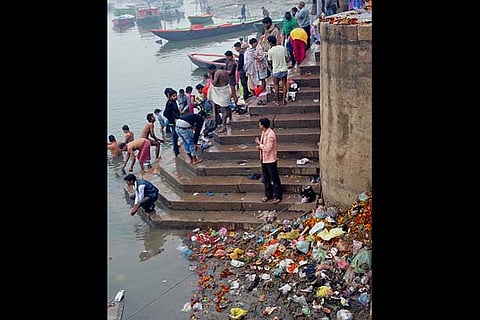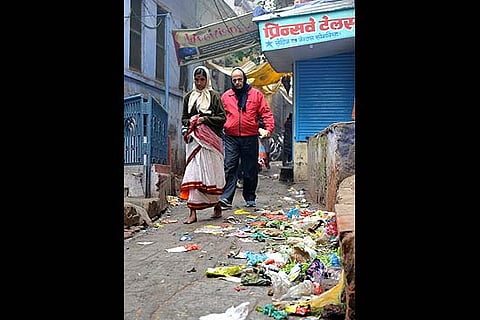Kyoto Prototype
Noida Upon The Ganges?
Banarasis take filth for granted, it’s Modi’s grand plans they fear
- Land prices have shot up in and around the city
- 2,700 municipal scavengers denied soap, water, protective gear
- 40,000 boatmen apprehensive of big, mechanised boats
- Farmers cultivating on riverbeds concerned about the future
- River cruise and river transportation of coal and raw materials, rather than reducing pollution, are said to be the priorities; local BJP aspires to a new ‘Noida’
- Some sections upset at demolition of old structures; and plans for malls
***
If cleanliness begins at home, then Narendra Modi more than honoured that cliche. In November, he picked up a shovel for Varanasi, the constituency he chose to represent in Parliament over Vadodara, though he polled more votes in the latter. If a broom launched the Swachh Bharat Abhiyan, he pitched for a Swachh Banaras on the city’s famed Assi Ghat. Not that Assi Ghat was really ‘dirty’, just that it was buried under a lot of silt. But Modi had spoken, and the ghat cleaning project was soon adopted by Deepak Madhok, an education entrepreneur and a former Nagar Nigam member. The PM met Madhok briefly, before announcing that local organisations would clean Assi Ghat within a month.
Madhok hired scores of trucks to ferry the silt, children from his schools joined the cause as well. The ‘cleanliness drive’ attracted sufficient media attention, sufficient enough for Amitabh Bachchan to interview Madhok live on television. However, Madhok wasn’t the only one enthused about swachhta, the local BJP unit too was raring to do its bit. Days before the PM’s next visit, a ‘rival’ organisation took over—or at least was given credit for—cleaning up Assi Ghat. Hurt, Madhok retreated with his trucks. Later, when he and his wife Bharti came to hear Modi speak at the ghat on Christmas Day—or Good Governance Day if you will—they were turned away. Furious, Madhok walked into the media enclosure, and gave a series of interviews on how the BJP had stolen his thunder, humiliated student participants and broke everyone’s heart, despite their contribution to Swachh Banaras. “I had met Modi,” says Madhok. “He seemed okay with us. Perhaps he doesn’t even know why I wasn’t on stage with him in December.” Assi Ghat was still being cleaned, by the other organisation, a month past Modi’s deadline.
For all Varanasi's other-worldly claims, the BJP has strategic goals here. With an eye on votes from neighbouring Bihar and regional UP, Swachh Bharat is BJP's tool to play this-worldly politics around dirt. The city has a long way to go before it can be 'smart' like the party wants it to be. The PM has signed an MoU with Japan to develop Varanasi like Kyoto, but as UP’s young chief minister Akhilesh Yadav said sarcastically, Santiago would be more the model for the PM’s cleanliness navratna.
No potshots, however, can deter the BJP in the state. “Ganga ghat should get a Mall Road,” declares BJP leader Vaibhav Kapoor. “City air will be cleaner after a ring road and decongested with satellite towns. We can be like Noida.”
“People have strong reasons to worry that grand plans are here again,” says activist Pramil Pandey. Expectations of land acquisition for the new satellite towns has fuelled a 60 per cent hike in land prices over these months, say locals. Lakhs of farmers who cultivate the river bed between Allahabad and Varanasi—a practice not contingent on land ownership—worry the new land acquisition ordinance will spell doom for them.

The 40,000-strong boatman community, who backed the BJP, have their own set of worries. “We hear of plans to dredge the river so that big boats can ply. If big ferries arrive, we’ll be finished,” says boatman Dinesh.
Meanwhile, gully and ghat demolitions in the inner city are getting controversial. “Demolition of illegal structures is critical to developing old Varanasi,” says Vaibhav Kapoor. But Gaurav Kapoor, a businessman and organiser of Banaras Utsav, is uncomfortable about the demolitions in Shankar ki Nagri. “It’s irritating when politicians’ plans are only on paper but everybody distributes gyaan.”
A Modi-fied local BJP is deaf to even a murmur of dissent. “People are now experiencing an awakening in Banaras,” says Shiv Sharan Pathak, the man in charge of the PM’s Varanasi office. “It happened since Narendra Modiji graced us with his presence.”
So, who walks the talk then? The BJP controls the municipality, yet berates the Samajwadi Party government in the state for the city’s plight. Varanasi’s 2,700 sanitation workers are responsible for the city’s sanitation. “But no funds have arrived, not from the Centre, not the nigams, nor corporates,” says Ravindra Jaiswal, BJP MLA from North Varanasi.
The local BJP unit also alleges “administrative sabotage” to Modi’s plan for a trade facilitation centre, which the PM regretted was too far from the weavers. “We had waited two months for land within Varanasi,” says Jaiswal. But as district magistrate Pranjal Yadav said, “The land they wanted belongs to a private trust. How could it be handed over?”
Perhaps the BJP in UP believes they have only till 2017 to worry. Jaiswal is confident the “next UP government will be ours”. Swachh Uttar Pradesh, he is convinced, is on its way to becoming the party’s electoral plank in 2017, the year UP votes. In the interim, he plans to launch a pilot project in one locality through a Pune company to turn garbage into fuel. It will be funded partly from his salary, the rest—Rs 20 lakh—from donations.
If there is one thing that is in enough supply in Varanasi, it’s earnest suggestion. Leaders routinely offer such predictable advice like throwing waste in (the mostly non-existent) dustbins. Shopkeepers are expected to provide the dustbins, with no thought to where they will be emptied. And herein lies Varanasi’s main problem. Its rubbish has nowhere to go.
“If people use bins, at least Banaras won’t get dirtier,” says Pathak stubbornly. Any dirtier seems impossible for a city which was built for five lakh people but which houses 15 lakh (according to the last census), not to mention the constant stream of tourists that throng its ghats. Every office—including Modi’s local office—shop, street, home and gully has garbage next to it.

Till last year, a company called A to Z collected the city’s garbage from door to door under the Jawaharlal Nehru National Urban Renewal Mission. But it stopped because of performance and payment issues. The Nagar Nigam resumed garbage collection last month, but the (central government-funded) waste treatment plant at Karsada isn’t ready. So, Varanasi’s 650 metric tonnes of solid waste is dumped largely on the hapless villages on the outskirts. Only a fourth of Varanasi’s daily sewerage is treated. All 300 million litres of filth bounces off the city’s walls, then joins the Ganga. An earlier attempt had been made to redraw the course of the Assi river to the Ganga, in the hope of improved drainage. But somehow the river itself vanished and what remained in its place was a stinking cesspool.
But Varanasi and its people are unfazed. Tongue in cheek, they take pride in the fact that “we just can’t stop spitting paan”. Some even believe that the filth is part of the city’s charms, the profane coexisting with the sacred in some sort of cosmic unity.
But ancient Indian history professor Dr Rahul Raj, who teaches at the Banaras Hindu University, espies a deeper controversy to Mission Swachhta. “It has a hidden agenda,” he says, “Sanskritisation. They are trying to politically confuse the poor Dalits in Varanasi.” RSS workers feeding Dalits khichdi recently following a shakha exhorting all Hindus to unite was of a piece with this plan, he feels.
Narendra Modi would perhaps not know of Pappu. At night, when the tidal flow of sewage under overburdened Varanasi recedes, Pappu strips down to his briefs and flushes out the excreta from the sewers. The work is demeaning, illegal, but goes on regardless. Pappu sometimes toils for 15 nights a month, under pressure from his employers—the Nagar Nigam contractors—to go deeper into the filthy canals. What does he think of the Swachh Bharat Abhiyan, the mammoth Rs 1.4 lakh crore programme to ‘clean India’ by 2019? Sitting outside his tumbledown shack in ‘Malin’ Basti, Maldahiya, he points at the rubble in the distance, “Those were toilets that stopped working in 2006. Nobody came to fix them.” As the firewood stoves spread a smoky haze, figures trot atop the rubble, squat, then scurry away.
At work, even more cruelly, sanitation workers like him get no soap, no water, nor protective gear. “They should do something for safaiwalas so that we can live normal lives. There should be some yojana for us,” says Pappu.
“They don’t bother about us, because we are Harijan,” says Kishan Kumar, 19, from the same basti. Cleanliness is routinely confused with a limited middle-class notion of civic sense, ignoring the socio-economic realities filth encounters—and creates. Some proponents of Swachh Bharat unconsciously even link some castes with uncleanliness. The prime minister himself chose to kick off the scheme from Valmiki Colony in the national capital. The casteist implications were lost in the jazzy photo-ops of the prime minister with a broom. But Pappu knows better.
This version has been edited
By Pragya Singh in Varanasi
Tags